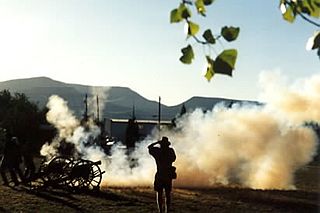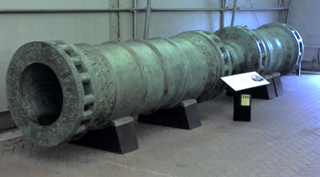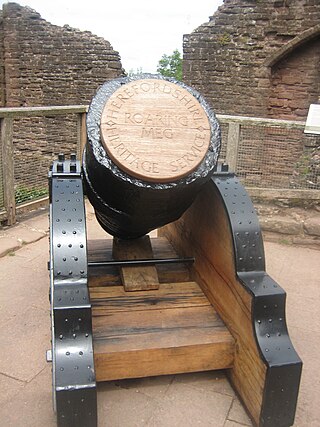
The formal definition of large-calibre artillery used by the United Nations Register of Conventional Arms (UNROCA) is "guns, howitzers, artillery pieces, combining the characteristics of a gun, howitzer, mortar, or multiple-launch rocket system, capable of engaging surface targets by delivering primarily indirect fire, with a calibre of 75 mm (3.0 in) and above". This definition, shared by the Arms Trade Treaty and the Treaty on Conventional Armed Forces in Europe, is updated from an earlier definition in United Nations General Assembly Resolution 46/36L, which set a threshold of 100 mm (3.9 in). Several grammatical changes were made to that latter in 1992 and the threshold was lowered in 2003 to yield the current definition, as endorsed by UN General Assembly Resolution 58/54.

Mons Meg is a medieval bombard in the collection of the Royal Armouries, on loan to Historic Environment Scotland and located at Edinburgh Castle in Scotland. It has a barrel diameter of 20 inches (510 mm), making it one of the largest cannons in the world by calibre.

The bombard is a type of cannon or mortar which was used throughout the Middle Ages and the early modern period. Bombards were mainly large calibre, muzzle-loading artillery pieces used during sieges to shoot round stone projectiles at the walls of enemy fortifications, enabling troops to break in. Most bombards were made of iron and used gunpowder to launch the projectiles. There are many examples of bombards, including Mons Meg, the Dardanelles Gun, and the handheld bombard.

Dulle Griet, also known as Mad Meg, is a figure of Flemish folklore who is the subject of a 1563 oil-on-panel by Flemish renaissance artist Pieter Bruegel the Elder. The painting depicts a virago, Dulle Griet, who leads an army of women to pillage Hell, and is currently held and exhibited at the Museum Mayer van den Bergh in Antwerp.

Gunpowder artillery in the Middle Ages primarily consisted of the introduction of the cannon, large tubular firearms designed to fire a heavy projectile over a long distance. Guns, bombs, rockets and cannons were first invented in China during the Han and Song dynasties and then later spread to Europe and the Middle East during the period.

Cannon operation required specialised crew and gunners, who were first enlisted by the Spanish in the 14th century. The nature of cannon operation often depended on the size of the cannon and whether they were breech-loading or muzzle-loading. English cannons of the late 14th century became mobile, while the largest cannon required huge crews to transport and operate them.
The history of cannons spans several hundred years from the 12th century to modern times. The cannon first appeared in China sometime during the 12th and 13th centuries. It was most likely developed in parallel or as an evolution of an earlier gunpowder weapon called the fire lance. The result was a projectile weapon in the shape of a cylinder that fired projectiles using the explosive pressure of gunpowder. Cannons were used for warfare by the late 13th century in the Yuan dynasty and spread throughout Eurasia in the 14th century. During the Middle Ages, large and small cannons were developed for siege and field battles. The cannon replaced prior siege weapons such as the trebuchet. After the Middle Ages, most large cannons were abandoned in favor of greater numbers of lighter, more maneuverable field artillery. New defensive fortifications such as bastions and star forts were designed specifically to better withstand artillery sieges. Cannons transformed naval warfare with its deadly firepower, allowing vessels to destroy each other from long range. As rifling became more commonplace, the accuracy of the cannon was significantly improved, and they became deadlier than ever, especially to infantry. In World War I, a considerable majority of all deaths were caused by cannons; they were also used widely in World War II. Most modern cannons are similar to those used in the Second World War, including autocannons—with the exception of naval guns, which are now significantly smaller in caliber.

Orban, also known as Urban, was an iron founder and engineer from Brassó, Transylvania, in the Kingdom of Hungary, who cast large-calibre artillery for the Ottoman siege of Constantinople in 1453.

Roaring Meg was the name of several powerful cannons used in the 17th century. It is not to be confused with Mons Meg, a medieval bombard preserved at Edinburgh Castle.

Museum Mayer van den Bergh is a museum in Antwerp, Belgium, housing the collection of the art dealer and collector Fritz Mayer van den Bergh (1858–1901). The major works are from the Gothic and Renaissance period in the Netherlands and Belgium, including paintings by Pieter Brueghel the Elder.

The Faule Mette or Faule Metze was a medieval large-calibre cannon of the city of Brunswick, Germany.

The Faule Grete was a medieval large-calibre cannon of the Teutonic Order. The bronze bombard was cast in 1409 in the cannon foundry of the Marienburg by the gunfounder Heynrich Dumechen. According to the account books of the order, the construction costs amounted to 278.5 Mark, a sum equivalent to ca. 1160 oxen.

The Pumhart von Steyr is a medieval large-calibre cannon from Styria, Austria, and the largest known wrought-iron bombard by caliber. It weighs around 8 t and has a length of more than 2.59 m. It was produced in the early 15th century and could fire, according to modern calculations, an 800 mm (31 in) stone ball weighing 690 kg (1,520 lb) to a distance of roughly 600 m (2,000 ft) after being loaded with 15 kg (33 lb) of gunpowder and set at an elevation of 10°.
The Grose Bochse was a medieval large-calibre cannon of the Teutonic Order. It was cast from June to September 1408 in several pieces and was presumably assembled by a screw or plug connection. The cannon was even bigger than the slightly later finished Faule Grete and may have reached the dimensions of the largest known bombard by caliber, the Pumhart von Steyr.

Artillery began to be used in France in the 14th century. The first depiction of a cannon in Europe appeared in Walter de Milemete's 1326 De nobilitatibus, sapientiis, et prudentiis regum. Small rudimentary weapons such as the pot-de-fer or the portable bâton à feu were introduced. At this early stage, cannon would fire either stone balls or metal pellets.
This is a timeline of the history of gunpowder and related topics such as weapons, warfare, and industrial applications. The timeline covers the history of gunpowder from the first hints of its origin as a Taoist alchemical product in China until its replacement by smokeless powder in the late 19th century.

The Boxted Bombard is a 15th-century cannon from England. The bombard is medium in size for its type, its military use is unknown due to a lack of historical records. For a long time unlocated, the piece was rediscovered for the public at the village of Boxted in the 1970s and is now on display at the artillery collection at Fort Nelson.













